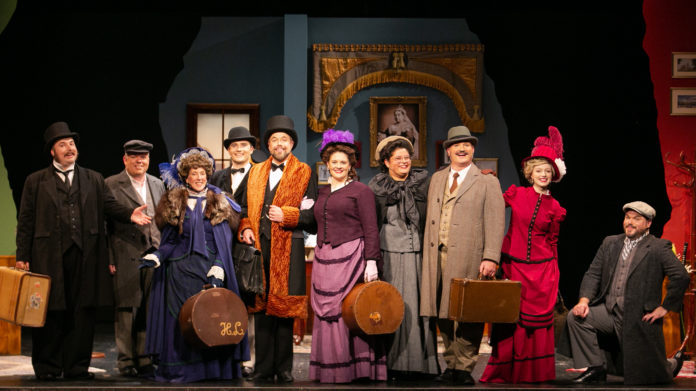Tarantara! Tarantara! is a musical play about the professional journeys of William Gilbert, Arthur Sullivan, and Richard D’Oyly Carte. It looks at their rise to fame, their operatic successes and failures, their fractious relationships with each other, and the eventual demise of their partnership. The play is a delight, and The Gilbert & Sullivan Society of SA’s production of it is a joyous experience that leaves you with tuneful patter on your lips and a satisfied smile on your face long after you leave the theatre.
You don’t have to be an operetta fan, or a G&S tragic, to enjoy Tarantara! Tarantara!, but it helps. Gilbert and Sullivan wrote fourteen operettas together – libretti by Gilbert, music by Sullivan, and production by D’Oyly Carte – and Tarantara! Tarantara! features song excerpts from many of them. The vocal work from the cast of eleven is first-rate. Not only is the show fabulous to listen to, without any weak links, it looks great. Tim de Jong and Vanessa Lee Shirley’s set is beautifully designed, and Trevaskis moves his cast through and around it with great care and intelligence. Anne Doherty’s properties team provide outstanding authenticity to the production, as do Helen and Ariana Snoswell’s costumes. Importantly, the cast really know how to wear their costumes, rather than the costumes wearing the actors! Richard Parkhill’s lighting design is up to his usual high standard, and greatly add to the ambience of the show. (The footlight and limelight effects are especially noteworthy, as is the sensitive cross fading that expertly assisted to delineate time and place.)
The production elements are high, but it all counts for little if the cast is not up to the task. Trevaskis has cast well, and all the actors are excellent. Even those in the smaller roles shine and leave you with a positive impression. Megan Doherty, Hazel Green, Vanessa Lee Shirley, James Nicholson, Suriya Umapthysivam, Grace Carter and Anthony Little variously play the roles of stagehands, employees, actors, singers, supernumeraries, paramours, narrators, and the like. They provide the glue that keeps the narrative flowing. Their timing is precise, and their individual and ensemble vocal work is strong and always enjoyable.
But the show turns on the talents of the principals, who are superb. Nicholas Bishop as Gilbert is formidable, and from the very outset it is clear that Gilbert is an arrogant force of nature. Paul Briske plays a proud Sullivan who is a servant to his trade. Andrew Crispe is a standout as D’Oyly Carte, who comes across as the urbane, dashing, and mannered entrepreneur who is used to getting his own way. Their diction to a person is superb, and their vocal numbers are polished and utterly entertaining. Nicholas Munday confidently plays the famed thespian George Grossmith, who starred in many of Gilbert and Sullivan’s productions. With more rounded vowels and less crisp consonants, Munday’s vocal quality is not as clear as the other principals, but his stagecraft is engaging. It is difficult not to closely watch him as he struts his stuff on stage. Like Crispe, Munday demands (and gets) attention!
As said above, Tarantara! Tarantara! is as much a musical play as it is a musical. To a degree the drama is ‘the thing’ rather than the music and the singing, but they do go hand in hand. However, at the beginning of Act 2 there is an extended vocal section that is arguably a little excessive: as enjoyable as it is, it doesn’t really add to the unfolding of the drama. Unsurprisingly, the role of the musical director is vital to the success of the production, and Christine Hodgen has produced the goods in spades. She is also the répétiteur and never puts a finger out of place. Her tempi are considered, and her timing and cueing are faultless. She is possibly the best accompanist this reviewer has ever seen on the theatrical stage. Hodgen plays off stage and is never seen by the audience (or cast, except for overhead TV monitors that are only visible to the cast). It was entirely appropriate that she took the final curtain call at the end of the show.
Director Richard Trevaskis and the entire company have produced a high quality that can only but impress.



